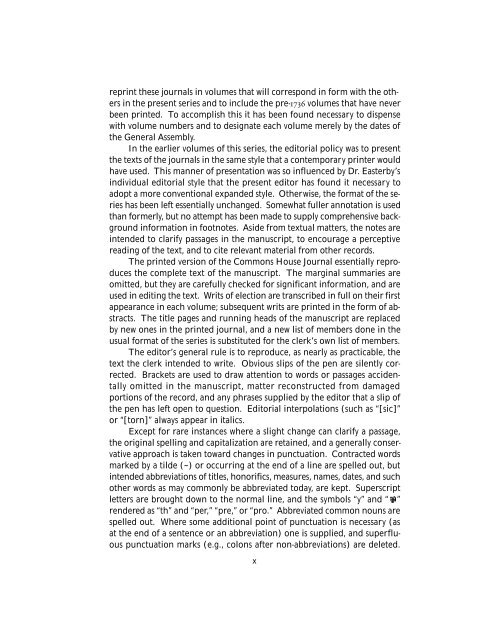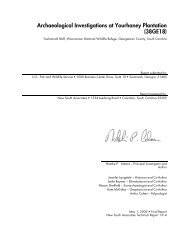The Journal of the Commons House of Assembly
The Journal of the Commons House of Assembly
The Journal of the Commons House of Assembly
You also want an ePaper? Increase the reach of your titles
YUMPU automatically turns print PDFs into web optimized ePapers that Google loves.
eprint <strong>the</strong>se journals in volumes that will correspond in form with <strong>the</strong> o<strong>the</strong>rsin <strong>the</strong> present series and to include <strong>the</strong> pre-1736 volumes that have neverbeen printed. To accomplish this it has been found necessary to dispensewith volume numbers and to designate each volume merely by <strong>the</strong> dates <strong>of</strong><strong>the</strong> General <strong>Assembly</strong>.In <strong>the</strong> earlier volumes <strong>of</strong> this series, <strong>the</strong> editorial policy was to present<strong>the</strong> texts <strong>of</strong> <strong>the</strong> journals in <strong>the</strong> same style that a contemporary printer wouldhave used. This manner <strong>of</strong> presentation was so influenced by Dr. Easterby’sindividual editorial style that <strong>the</strong> present editor has found it necessary toadopt a more conventional expanded style. O<strong>the</strong>rwise, <strong>the</strong> format <strong>of</strong> <strong>the</strong> serieshas been left essentially unchanged. Somewhat fuller annotation is usedthan formerly, but no attempt has been made to supply comprehensive backgroundinformation in footnotes. Aside from textual matters, <strong>the</strong> notes areintended to clarify passages in <strong>the</strong> manuscript, to encourage a perceptivereading <strong>of</strong> <strong>the</strong> text, and to cite relevant material from o<strong>the</strong>r records.<strong>The</strong> printed version <strong>of</strong> <strong>the</strong> <strong>Commons</strong> <strong>House</strong> <strong>Journal</strong> essentially reproduces<strong>the</strong> complete text <strong>of</strong> <strong>the</strong> manuscript. <strong>The</strong> marginal summaries areomitted, but <strong>the</strong>y are carefully checked for significant information, and areused in editing <strong>the</strong> text. Writs <strong>of</strong> election are transcribed in full on <strong>the</strong>ir firstappearance in each volume; subsequent writs are printed in <strong>the</strong> form <strong>of</strong> abstracts.<strong>The</strong> title pages and running heads <strong>of</strong> <strong>the</strong> manuscript are replacedby new ones in <strong>the</strong> printed journal, and a new list <strong>of</strong> members done in <strong>the</strong>usual format <strong>of</strong> <strong>the</strong> series is substituted for <strong>the</strong> clerk’s own list <strong>of</strong> members.<strong>The</strong> editor’s general rule is to reproduce, as nearly as practicable, <strong>the</strong>text <strong>the</strong> clerk intended to write. Obvious slips <strong>of</strong> <strong>the</strong> pen are silently corrected.Brackets are used to draw attention to words or passages accidentallyomitted in <strong>the</strong> manuscript, matter reconstructed from damagedportions <strong>of</strong> <strong>the</strong> record, and any phrases supplied by <strong>the</strong> editor that a slip <strong>of</strong><strong>the</strong> pen has left open to question. Editorial interpolations (such as “[sic]”or “[torn]” always appear in italics.Except for rare instances where a slight change can clarify a passage,<strong>the</strong> original spelling and capitalization are retained, and a generally conservativeapproach is taken toward changes in punctuation. Contracted wordsmarked by a tilde (~) or occurring at <strong>the</strong> end <strong>of</strong> a line are spelled out, butintended abbreviations <strong>of</strong> titles, honorifics, measures, names, dates, and sucho<strong>the</strong>r words as may commonly be abbreviated today, are kept. Superscriptletters are brought down to <strong>the</strong> normal line, and <strong>the</strong> symbols “y” and “ ”rendered as “th” and “per,” “pre,” or “pro.” Abbreviated common nouns arespelled out. Where some additional point <strong>of</strong> punctuation is necessary (asat <strong>the</strong> end <strong>of</strong> a sentence or an abbreviation) one is supplied, and superfluouspunctuation marks (e.g., colons after non-abbreviations) are deleted.x







